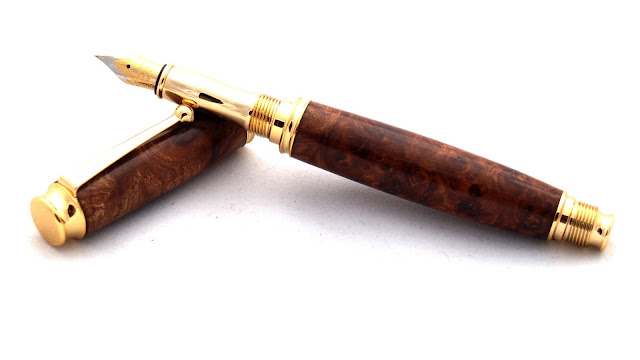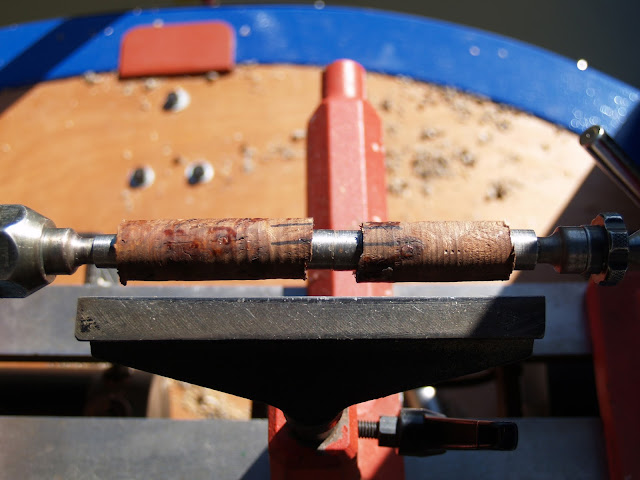Rare Elm Burr and 24ct Gold Plated Rollerball Pen
A burr (American burl) is a tree growth in which the grain has grown in a deformed manner. It is commonly found in the form of a rounded outgrowth on a tree trunk or branch that is filled with small knots from dormant buds.
A burr results from a tree undergoing some form of stress. It may be environmental or introduced by humans. Most burr grow beneath the ground, attached to the roots as a type of malignancy that is generally not discovered until the tree dies or falls over. Such burrs sometimes appear as groups of bulbous protrusions connected by a system of rope-like roots. Almost all burr wood is covered by bark, even if it is underground. Insect infestation and certain types of mould infestation are the most common causes of this condition.
Burr yields a very peculiar and highly figured wood, one prized for its beauty by many; its rarity also adds to its expense. It is sought after by people such as furniture makers (mainly used as veneers, artists, and wood sculptors. The knots and twists in oak Burrs are usually a few per foot or so, however these pens have many more to make a spectacular premium quality dressing for only the best of the pen mechanisms that I sell.
Seasoning burr can be a long drawn out process that can take many years and there is no guarantee that there will be any usable timber once it is sawn.
Leaving Penkridge a day earlier than we may have liked (visitor moorings are often restricted to 48 hours only) we wound our way to to Autherley Junction via Gailey and its well known round toll-keepers watch tower. This piece of canal is particularly twisty being a little older and a contour (literally follows the contour of the hills) rather than the much straighter cutting and embankment style that we would soon be going on to. In fact we passed a very modern looking recycling centre complete with living turfed roof and we were still twisting and turning around the back of it about an hour later.
The only other notable feature of the canal towards the end of our journey was a mile or so of what was labeled on our map as ‘very narrow cutting’. It certainly was too. Long sections where the canal was about six inches wider than the boat, and shallow too. It is fine as long as there aren't any boats coming the other way, or you are unlucky enough to break down - ah spoken too soon. Yes we came to a grinding halt in the narrows, our prop was fouled and not with the usual bin bags or a random T-shirt that would have allowed us to carry on but something big and heavy and noisy as the prop tried to swing itself around.
We are quite used to rushing down the engine hole to see what's gone wrong but it takes a couple of minutes to take the deck boards up, then move a wood bench off the engine covers so there is a bit of room and get down to the weed hatch which is about a foot below deck level, then unscrew the heavy steel bar that holds the weed hatch in place before the delights of the murky canal await another six inches lower. Now what is down there? Far too murky to see so its roll the sleeves up and dive into the unknown. This time it was a large and heavy rope fender that was jammed between the prop and the rudder, complete with a plastic bracket to hold it to a narrowboat roof. What was annoying is that this was entirely avoidable as a narrowboats fenders should really be raised when you are moving and just put down for mooring. Every year there are stories of boats wedged into narrow locks because their fenders took up the valuable spare couple of inches down the side of the boat.
After our delay in the narrows we arrived at Autherley Junction (on the borders of Wolverhampton) just as the sun was dipping down and changing our warm spring cruise into one that was threatening a frost for the next day. Not an inspiring location and the one and only reason that we wanted to spend at least a few days here is that there is a nice solid concrete bank and a turning point at the junction and we would be able to spend a little TLC on our boats paintwork. The battle scars of 2015 were still showing and needed a couple of coats of primer, some undercoat and some rather expensive enamel blue topcoat.
Luckily the weather was fab and I was able to get a few pens finished too.
You can follow my pen making here on this blog and our travels on another blog here
oh and please like us on Facebook too here
https://www.facebook.com/ThePenMakersBoat
https://www.facebook.com/ThePenMakersBoat











No comments:
Post a Comment
Thanks for commenting, you can always contact me via email at thepenmakersboat@gmail.com or find The Pen Makers Boat on Facebook. I'll get back to you as soon as I can.